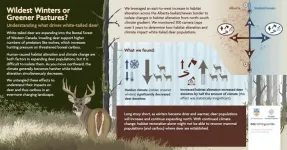(Press-News.org) In looking up at the sky during these early weeks of spring, you may very well see a flock of birds moving in unison as they migrate north. But how do these creatures fly in such a coordinated and seemingly effortless fashion?
Part of the answer lies in precise, and previously unknown, aerodynamic interactions, reports a team of mathematicians in a newly published study. Its breakthrough broadens our understanding of wildlife, including fish, who move in schools, and could have applications in transportation and energy.
“This area of research is important since animals are known to take advantage of the flows, such as of air or water, left by other members of a group to save on the energy needed to move or to reduce drag or resistance,” explains Leif Ristroph, an associate professor at New York University’s Courant Institute of Mathematical Sciences and the senior author of the paper, which appears in the journal Nature Communications. “Our work may also have applications in transportation—like efficient propulsion through air or water—and energy, such as more effectively harvesting power from wind, water currents, or waves.”
The team’s results show that the impact of aerodynamics depends on the size of the flying group—benefiting small groups and disrupting large ones.
“The aerodynamic interactions in small bird flocks help each member to hold a certain special position relative to their leading neighbor, but larger groups are disrupted by an effect that dislodges members from these positions and may cause collisions,” notes Sophie Ramananarivo, an assistant professor at École Polytechnique Paris and one of the paper’s authors.
Previously, Ristroph and his colleagues uncovered how birds move in groups—but these findings were drawn from experiments mimicking the interactions of two birds. The new Nature Communications research expanded the inquiry to account for many flyers.
To replicate the columnar formations of birds, in which they line up one directly behind the other, the researchers created mechanized flappers that act like birds’ wings. The wings were 3D-printed from plastic and driven by motors to flap in water, which replicated how air flows around bird wings during flight. This “mock flock” propelled through water and could freely arrange itself within a line or queue, as seen in a video of the experiment.
The flows affected group organization in different ways—depending on the size of the group.
For small groups of up to about four flyers, the researchers discovered an effect by which each member gets help from the aerodynamic interactions in holding its position relative to its neighbors.
“If a flyer is displaced from its position, the vortices or swirls of flow left by the leading neighbor help to push the follower back into place and hold it there,” explains Ristroph, director of NYU’s Applied Mathematics Laboratory, where the experiments were conducted. “This means the flyers can assemble into an orderly queue of regular spacing automatically and with no extra effort, since the physics does all the work.
“For larger groups, however, these flow interactions cause later members to be jostled around and thrown out of position, typically causing a breakdown of the flock due to collisions among members. This means that the very long groups seen in some types of birds are not at all easy to form, and the later members likely have to constantly work to hold their positions and avoid crashing into their neighbors.”
The authors then deployed mathematical modeling to better understand the underlying forces driving the experimental results.
Here, they concluded that flow-mediated interactions between neighbors are, in effect, spring-like forces that hold each member in place—just as if the cars of a train were connected by springs.
However, these “springs” act in only one direction—a lead bird can exert force on its follower, but not vice versa—and this non-reciprocal interaction means that later members tend to resonate or oscillate wildly.
“The oscillations look like waves that jiggle the members forwards and backwards and which travel down the group and increase in intensity, causing later members to crash together,” explains Joel Newbolt, who was an NYU graduate student in physics at the time of research.
The team named these new types of waves “flonons,” which is based on the similar concept of phonons that refer to vibrational waves in systems of masses linked by springs and which are used to model the motions of atoms or molecules in crystals or other materials.
“Our findings therefore raise some interesting connections to material physics in which birds in an orderly flock are analogous to atoms in a regular crystal,” Newbolt adds.
The study’s other authors included the Courant Institute’s Nickolas Lewis, Mathilde Bleu, Jiajie Wu, and Christiana Mavroyiakoumou.
The work was supported by grants from the National Science Foundation (DMS-1847955, DMS-1646339).
# # #
END
How do birds flock? Researchers do the math to reveal previously unknown aerodynamic phenomenon
Findings have potential applications for transportation and energy
2024-04-25
ELSE PRESS RELEASES FROM THIS DATE:
Experts call for global genetic warning system to combat the next pandemic and antimicrobial resistance
2024-04-25
The Covid-19 pandemic turned the world upside down. In fighting it, one of our most important weapons was genomic surveillance, based on whole genome sequencing, which collects all the genetic data of a given microorganism. This powerful technology tracked the spread and evolution of the virus, helping to guide public health responses and the development of vaccines and treatments.
But genomic surveillance could do much more to reduce the toll of disease and death worldwide than just protect us from Covid-19. Writing in Frontiers in Science, an international collective of clinical and public health microbiologists ...
Genetic variations may predispose people to Parkinson’s disease following long-term pesticide exposure, study finds
2024-04-25
A new UCLA Health study found certain genetic variants could help explain how long-term pesticide exposure could increase the risk of Parkinson’s disease.
While decades of research have linked pesticide exposure and Parkinson’s disease risk, researchers have sought to explain why some individuals with high exposure develop the disease while others do not.
One longstanding hypothesis has been that susceptibility to the disease is a combination of both environmental and genetic factors.
The new study, published in the journal NPJ Parkinson’s Disease, used genetic data from nearly 800 Central Valley (California) residents with Parkinson’s ...
Deer are expanding north, and that’s not good for caribou
2024-04-25
As the climate changes, animals are doing what they can to adapt.
Researchers from UBC Okanagan—which includes partners from Biodiversity Pathways’ Wildlife Science Centre, the Alberta Biodiversity Monitoring Institute, the University of Alberta, and Environment and Climate Change Canada—wanted to evaluate why deer densities in the boreal forest are rapidly increasing.
Over the past century, white-tailed deer have greatly expanded their range in North America, explains Melanie Dickie, a doctoral student with UBC Okanagan’s Wildlife Restoration Ecology Lab.
In the boreal forest of Western Canada, ...
Puzzling link between depression and cardiovascular disease explained at last: they partly develop from the same gene module
2024-04-25
Depression and cardiovascular disease (CVD) are serious concerns for public health. Approximately 280 million people worldwide have depression, while 620 million people have CVD. It has been known since the 1990s that the two diseases are somehow related. For example, people with depression run a greater risk of CVD, while effective early treatment for depression cuts the risk of subsequently developing CVD by half. Conversely, people with CVD tend to have depression as well. For these reasons, the American Heart Association (AHA) advises to monitor teenagers with depression ...
Synthetic droplets cause a stir in the primordial soup
2024-04-25
Our bodies are made up of trillions of different cells, each fulfilling their own unique function to keep us alive.
How do cells move around inside these extremely complicated systems? How do they know where to go? And how did they get so complicated to begin with? Simple yet profound questions like these are at the heart of curiosity-driven basic research, which focuses on the fundamental principles of natural phenomena. An important example is the process by which cells or organisms move in response to chemical signals in their environment, also known as chemotaxis.
A constellation of researchers from three different research units at the Okinawa Institute of Science ...
Future parents more likely to get RSV vaccine when pregnant if aware that RSV can be a serious illness in infants
2024-04-25
A nationwide survey of people who were pregnant or trying to become pregnant found that overall 54 percent expressed interest in the RSV vaccine during pregnancy. Perceiving RSV as a serious illness in infants was the strongest predictor of likely vaccination during pregnancy. Likelihood to receive the RSV vaccine during pregnancy was also higher among parents with a child at home already. Findings were published in the journal Pediatrics.
Respiratory syncytial virus (RSV) is a leading cause of infection among infants, frequently resulting in hospital or intensive care admission. RSV infection severe enough to require hospitalization has been associated with long-term wheezing ...
Microbiota enterotoxigenic Bacteroides fragilis-secreted BFT-1 promotes breast cancer cell stemness and chemoresistance through its functional receptor NOD1
2024-04-25
Tumor-resident microbiota in breast cancer promotes both the initiation and progression of cancer. However, the potential of targeting microbiota to enhance the efficacy of breast cancer treatment has not been comprehensively explored. In this study, researchers analyzed the microbial composition within breast tumors and identified a notable enrichment of ETBF in patients who exhibited resistance to taxane-based neoadjuvant chemotherapy.
Key findings from the study include:
Even at low biomass levels, ETBF ...
The Lundquist Institute receives $2.6 million grant from U.S. Army Medical Research Acquisition Activity to develop wearable biosensors
2024-04-25
The U.S. Army Medical Research Acquisition Activity (USAMRAA) has awarded The Lundquist Institute (TLI) a four-year grant totaling $2,623,234. The research project is led by Dr. Harry Rossiter, an investigator at TLI and Professor at the David Geffen School of Medicine at UCLA. The project aims to develop wearable multiplex biosensors to monitor exacerbation risk in chronic obstructive pulmonary disease (COPD).
COPD affects approximately 16 million Americans and is the third leading cause of death globally. Acute exacerbations of COPD (AECOPD), typically caused by a lung infection, are associated ...
Understanding the cellular mechanisms of obesity-induced inflammation and metabolic dysfunction
2024-04-25
A research team led by Professor Jong Kyoung Kim and Yujin Jeong (PhD candidate), from the Department of Life Sciences at Pohang University of Science and Technology (POSTECH) in collaboration with Professor Yun-Hee Lee and Cheoljun Choi (PhD candidate) from the College of Pharmacy at Seoul National University, Professor Young-Min Hyun and Koung-Min Park (PhD candidate) from Yonsei University College of Medicine, Professor James Granneman from Wayne State University (WSU), and Professor Young-Suk Jung from the College of Pharmacy at Pusan National University, ...
Study highlights increased risk of second cancers among breast cancer survivors
2024-04-25
Survivors of breast cancer are at significantly higher risk of developing second cancers, including endometrial and ovarian cancer for women and prostate cancer for men, according to new research studying data from almost 600,000 patients in England.
For the first time, the research has shown that this risk is higher in people living in areas of greater socioeconomic deprivation.
Breast cancer is the most commonly diagnosed cancer in the UK. Around 56,000 people in the UK are diagnosed each year, the vast majority (over 99%) of whom are women. Improvements in earlier diagnosis and in treatments mean that ...
LAST 30 PRESS RELEASES:
Post-stroke injection protects the brain in preclinical study
Cardiovascular risk score predicts multiple eye diseases
Health: estimated one in ten British adults used or interested in GLP-1 medications for weight loss
Exercise to treat depression yields similar results to therapy
Whooping cough vaccination for pregnant women strengthens babies’ immune system
Dramatic decline in new cases of orphanhood in Uganda driven by HIV treatment and prevention programs
Stopping weight loss drugs linked to weight regain and reversal of heart health markers
Higher intake of food preservatives linked to increased cancer risk
Mass General Brigham–developed cholera vaccine completes phase 1 trial
First experimental validation of a “150-year-old chemical common sense” direct visualization of the molecular structural changes in the ultrafast anthracene [4+4] photocycloaddition reaction
Lack of support for people on weight loss drugs leaves them vulnerable to nutritional deficiencies, say experts
Dogs’ dinners can have greater climate impact than owners’
Are you ready to swap salmon for sprats and sardines?
1.6 million UK adults used weight loss drugs in past year
American College of Cardiology comments on new dietary guidelines for Americans
American Society of Gene & Cell Therapy and Orphan Therapeutics Accelerator partner to advance and commercialize promising rare disease treatments
One in 14 patients having day case surgery have new or worse chronic pain 3 months after their operation
New study highlights link between eviction rates and gun violence
Heatwaves heat up soil but not toxin levels in rice, study finds
Digital modeling reveals where construction carbon emissions really come from
Turning farm waste into water filters
New study shows how the spleen helps the immune system accept a transplant
New Mayo Clinic study advances personalized prostate cancer education with an EHR-integrated AI agent
Researchers identify novel therapeutic target to improve recovery after nerve injury
Microbes in breast milk help populate infant gut microbiomes
Reprogramming immunity to rewrite the story of Type 1 diabetes
New tool narrows the search for ideal material structures
Artificial saliva containing sugarcane protein helps protect the teeth of patients with head and neck cancer
Understanding the role of linear ubiquitination in T-tubule biogenesis
Researchers identify urban atmosphere as primary reservoir of microplastics
[Press-News.org] How do birds flock? Researchers do the math to reveal previously unknown aerodynamic phenomenonFindings have potential applications for transportation and energy








